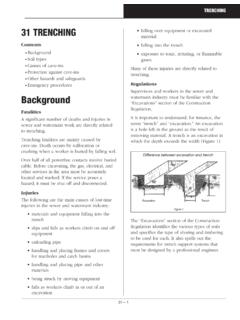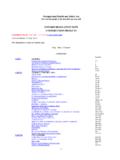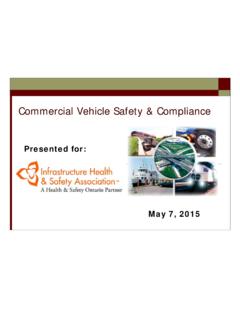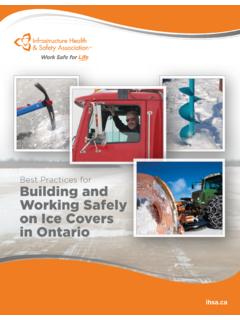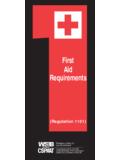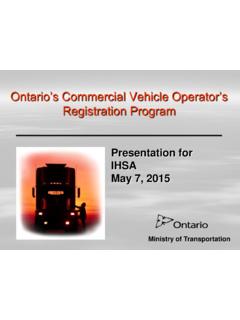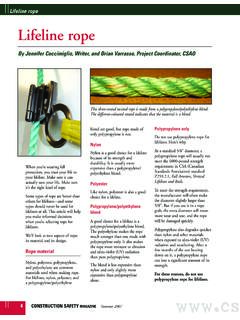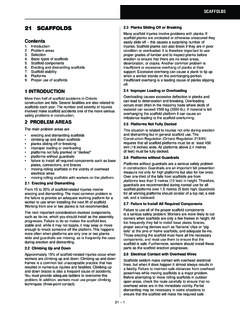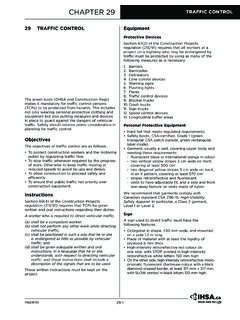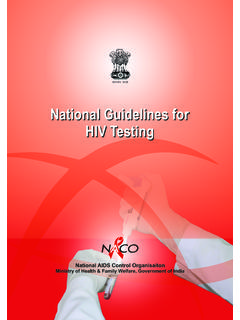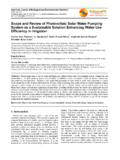Transcription of HOISTING and RIGGING Safety Manual - IHSA
1 HOISTING and RIGGINGS afety ManualInfrastructure health & Safety Association5110 Creekbank Rd., Suite 400 Mississauga, Ontario L4W 0A1 Canada(905) 625-01001-800-263-5024 Fax (905) the past, members of the public have used printed information that was outdated by subsequentimprovements in knowledge and technology. We therefore make the following statement for their protection in information presented here was, to the best of our knowledge, current at time of printing and isintended for general application. This publication is not a definitive guide to government regulations or topractices and procedures wholly applicable under every circumstance. The appropriate regulations andstatutes should be consulted. Although the Construction Safety Association of Ontario cannot guaranteethe accuracy of, nor assume liability for, the inf ormation presented here, we are pleased to answerindividual requests for counselling and advice. Construction Safety Association of Ontario, 1995 REVISED May 1997 REVISED April 2001 REVISED January 2007 REVISED September 2008 ISBN-13: 978-0-919465-70-1 DisclaimerThe contents contained in this publication are for general inf ormation only.
2 This publicationshould not be regarded or relied upon as a definitive guide to government regulations or tosafety practices and procedures. The contents of this publication were, to the best of ourknowledge, current at the time of printing. However, no representations of any kind are madewith regard to the accuracy, completeness, or sufficiency of the contents. The appropriateregulations and statutes should be consulted. Readers should not act on the informationcontained herein without seeking specific independent legal advice on their specificcircumstance. The Infrastructure health & Safety Association is pleased to answer individualrequests for counselling and advice. Infrastructure health and Safety Association, 1995 Revised, May 1997 Revised, April 2001 Revised, January 2007 Revised, September 2008 Revised, September 2009 Second printing, August 2010 Third printing, August 2011 Fourth printing, March 2012 ISBN-13: 978-0-919465-70-1 TABLE of CONTENTSI ntroduction1 Section 1: HOISTING and RIGGING Hazards3 Procedures and Precautions5 Determining Load Weights15 Weights of Common Materials17 Section 2: Fibre Ropes, Knots, Hitches19 Fibre Rope Characteristics20 Inspection of Fibre Rope21 Working Load Limit (WLL)22 Care, Storage, Use23 Knots and Hitches26 Section 3: Hardware, Wire Rope, Slings30 Wire Rope31 Sling Configurations43 Sling Angles49 Centre of Gravity51 Sling WLLs53 Sling Types60 RIGGING Hardware71 HOISTING Tips72 Section 4.
3 RIGGING Tools and Devices83 Jacks85 Blocking and Cribbing88 Rollers89 Inclined Planes90 Lever-Operated Hoists91 Chain Hoists91 Grip-Action Hoists or Tirfors93 Electric Hoists and Pendant Cranes95 Winches97 Anchorage Points98 Section 5: Introduction to Crane Operations103 Responsibilities105 Basic Types and Configurations107 Hazards in Crane Operating Areas122 Working near Powerlines126 Factors Affecting Crane Capacity132 Setup Summary155 Machine Selection156 Signalling1581 INTRODUCTIONP urpose of this ManualThis Manual is intended as a working guide for training workers and supervisors in the fundamentalsof safe RIGGING and information covers not only ropes and knots but HOISTING equipment from cranes to chainfallsand RIGGING hardware from rope clips to spreader beams. Equally important is the attention paid atevery point to correct procedures for inspection, maintenance, and of the equipment and materials with which we work is one of the most importantfactors in occupational health and Safety .
4 Each item has been designed and developed to serve aspecific purpose. Recognizing its capabilities and limitations not only improves efficiency butminimizes hazards and helps prevent Manual identifies the basic hazards in RIGGING and HOISTING , explains the safeguards necessaryto control or eliminate these hazards, and spells out other essential Safety information should be used in conjunction with the applicable regulations by contractors,supervisors, operators, riggers, and others delivering or receiving instruction in the basics of saferigging and and Safety LawOccupational health and Safety ActSafety legislation for Ontario construction in general consists of the Occupational health andSafety Act, which came into force on 1 October 1979. Its purpose is to protect workers againsthealth and Safety hazards on the Occupational health and Safety Actis based on the internal responsibility concept formanagement and workers. This encourages both groups to work out solutions to health and safetyproblems with the guidance of the Ministry of Act provides us with the framework and the tools to achieve a safe and healthy workplace.
5 Itsets out the rights and duties of all parties in the workplace. It establishes procedures for dealingwith job-site hazards and provides for enforcement of the law where compliance has not beenachieved the years the Acthas been revised to meet the changing requirements of Ontario are various regulations under the Act for construction in most extensive is the Construction Regulation (Ontario Regulation 213/91). There are alsospecial regulations for controlled products under the Workplace Hazardous Materials InformationSystem (WHMIS) and for designated substances such as regulations are generally based on health and Safety problems that have recurredover the years. In many cases, the regulations have been proposed jointly by management andlabour groups as a means of controlling or eliminating problems that have historically resulted infatalities, lost-time injuries, and occupational Construction Regulation has been periodically revised over the Ontario s Occupational health and Safety Act, the Construction Regulation, and otherapplicable health and Safety regulations to make sure that you know what to expect from otherson the job and what others expect from 1 HOISTING and RIGGING Hazards Procedures and Precautions Determining Load Weights Weights of Common Materials4 Section 1 HOISTING and RIGGING HazardsIt is important that workers involved with HOISTING and RIGGING activities are trained in both safetyand operating procedures.
6 HOISTING equipment should be operated only by trained cause of RIGGING accidents can often be traced to a lack of knowledge on the part of a programs such as the Infrastructure health & Safety Association s Basic Safety Training forHoisting and Riggingprovide workers with a basic knowledge of principles relating to safe hoistingand RIGGING practices in the construction industry. A safe RIGGING operation requires the rigger to know the weight of the load and RIGGING hardware the capacity of the HOISTING device the working load limit of the HOISTING rope, slings, and hardware. When the weights and capacities are known, the rigger must then determine how to lift the loadso that it is and experience enable riggers to recognize hazards that can have an impact on a hoistingoperation. Riggers must be aware of elements that can affect HOISTING Safety , factors that reducecapacity, and safe practices in RIGGING , lifting, and landing loads. Riggers must also be familiar withthe proper inspection and use of slings and other RIGGING crane and RIGGING accidents can be prevented by field personnel following basic safe HOISTING and RIGGING practices.
7 When a crane operator is working with a rigger or a RIGGING crew, itis vital that the operator is aware of the all aspects of the lift and that a means of communicationhas been agreed upon, including what signals will be that can Affect HOISTING Safety Working Load Limit (WLL) not t assume. Know the working load limits of theequipment being used. Never exceed these limits. Defective all hardware, tackle, and slings before use. Destroydefective components. Defective equipment that is merely discarded may be picked up andused by someone unaware of its defects. Questionable not use equipment that is suspected to be unsafe or unsuitable, until its suitability has been verified by a competent person. Hazardous wind carry out a HOISTING or RIGGING operation when windscreate hazards for workers, the general public, or property. Assess load size and shape todetermine whether wind conditions may cause problems. For example, even though theweight of the load may be within the capacity of the equipment, loads with large wind-catching surfaces may swing or rotate out of control during the lift in high or gusting and rotating loads not only present a danger to riggers there is the potential forthe forces to overload the HOISTING equipment.
8 Weather the visibility of riggers or hoist crew is impaired by snow, fog,rain, darkness, or dust, extra caution must be exercised. For example, operate in all slow ,and if necessary, the lift should be postponed. At sub-freezing temperatures, be aware thatloads are likely to be frozen to the ground or structure they are resting on. In extreme coldconditions avoid shock-loading or impacting the hoist equipment and hardware, which mayhave become brittle. Electrical of the most frequent killers of riggers is electrocution. An electricalpath can be created when a part of the hoist, load line, or load comes into close proximity toan energized overhead powerline. When a crane is operating near a live powerline and theload, hoist lines, or any other part of the HOISTING operation could encroach on the minimumpermitted distance (see table on the next page), specific measures described in theConstruction Regulation must be taken. For example, constructors must have writtenprocedures to prevent contact whenever equipment operates within the minimum permitteddistance from a live overhead powerline.
9 The constructor must have copies of the procedureavailable for every employer on the project. Hoist line not workingload limits of HOISTING equipment applyonly to freely suspended loads onplumb hoist lines. If the hoist line is notplumb during load handling, side loadsare created which can destabilize theequipment and cause structural failureor tip-over, with little warning. Wrong. The hoist line must be plumb at all that Reduce Capacity The working load limits of HOISTING and RIGGING equipment are based on ideal conditions. Such idealcircumstances are seldom achieved in the field. Riggers must therefore recognize the factors thatcan reduce the capacity of the hoist. swinging of suspended loads creates additional dynamic forces on the hoist inaddition to the weight of the load. The additional dynamic forces (see point below) are difficultto quantify and account for, and could cause tip-over of the crane or failure of hoistinghardware.
10 The force of the swinging action makes the load drift away from the machine,increasing the radius and side-loading on the equipment. The load should be kept directlybelow the boom point or upper load block. This is best accomplished by controlling the load smovement with slow motions. Condition of rated working load limits apply only to equipment andhardware in good condition. Any equipment damaged in service should be taken out ofservice and repaired or destroyed. Dynamic working load limits of RIGGING and HOISTING equipment are determined forstatic loads. The design Safety factor is applied to account, in part, for the dynamic motions of theload and equipment. To ensure that the working load limit is not exceeded during operation, allowfor wind loading and other dynamic forces created by the movements of the machine and its sudden snatching, swinging, and stopping of suspended loads. Rapid acceleration anddeceleration also increases these dynamic forces.
